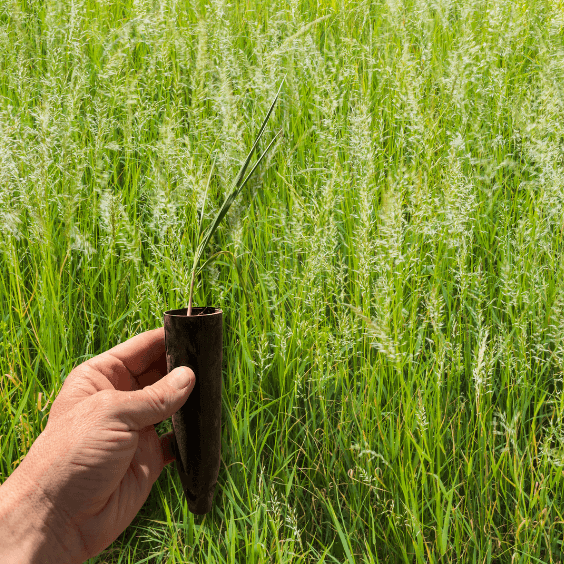Discover expert tips on cultivating and caring for sweetgrass plants.
Traditionally used in Native American ceremonies, sweetgrass is revered for its soothing fragrance and is often used in smudging rituals to purify spaces and invite positive energy. Besides its cultural significance, sweetgrass adds a unique aesthetic appeal to any garden or green space with its vibrant green blades and pleasant aroma. This guide provides you with detailed instructions on planting and caring for your sweetgrass plugs from Sacred Plant Co or any other sweetgrass plant you may have. This guide will help you ensure your sweetgrass can thrive and enhance the beauty of your surroundings. Learn about optimal soil preparation, watering techniques, and maintenance tips to cultivate healthy, flourishing sweetgrass plants.
Preparing for Your Sweetgrass Arrival
When purchasing your sweetgrass plugs from Sacred Plant Co, you'll receive a sturdy, ready-to-plant product. To ensure a successful planting, plan ahead and prepare for your sweetgrass's arrival by selecting an appropriate location. Sweetgrass thrives in partial to full sun exposure and requires well-draining soil. Consider the natural habitat of sweetgrass, which often includes moist meadows and prairie environments, to replicate similar conditions in your garden. Proper site selection and preparation will provide a strong foundation for your sweetgrass to grow and flourish.
Planting Your Sweetgrass Plugs
1. Site Selection Choose a location with full sun exposure for optimal growth. Sweetgrass thrives in moist conditions, similar to its natural habitats of marshes and riverbanks, but it also requires well-draining soil to prevent waterlogging. Enrich the soil with organic matter or compost before planting to provide additional nutrients and enhance soil structure.
2. Planting Process Once the threat of the last frost has passed, begin planting your sweetgrass plugs. Dig a hole twice the width and the same depth as the plug. Place the sweetgrass in the hole, ensuring the top of the plug is level with the soil surface. Backfill the hole with soil, pressing down firmly to eliminate air pockets, and water generously.
By following these steps, you can ensure your sweetgrass plants establish well and thrive in their new environment.
Taking Care of Your Sweetgrass
1. Watering
Sweetgrass enjoys moisture, but it's essential to avoid oversaturating the soil to prevent root rot. Generally, watering once a week is sufficient, but during particularly dry periods, more frequent watering may be necessary. The goal is to keep the soil consistently moist without becoming waterlogged. Monitor the soil's moisture level by checking it regularly; it should feel damp but not soggy. Adding mulch around the plants can help retain moisture and reduce the frequency of watering.
2. Fertilizing
While sweetgrass isn't a demanding plant in terms of nutrients, a little boost can stimulate growth for exceptional results. We apply Ancient Wisdom GROWTH. This natural fertilizer provides essential nutrients that enhance the plant's vigor and overall health. By incorporating this monthly feeding routine, you'll ensure your sweetgrass remains lush and robust throughout the growing season.
3. Pruning
To keep your sweetgrass manageable and encourage new growth, it's important to prune or mow it in late winter or early spring. Cut the plant back to about 4 inches in height. This trimming stimulates healthy new growth and helps maintain the plant's overall shape and vigor. Regular pruning also prevents the plant from becoming too dense, which can enhance air circulation and reduce the risk of disease.
4. Pests and Diseases
When well-maintained, sweetgrass is relatively resistant to diseases and pests. However, slugs and snails may find the plant attractive, especially in damp conditions. These pests can cause damage by feeding on the leaves. To manage them, you can manually remove the pests or use organic solutions like crushed eggshells or diatomaceous earth. Sprinkling these natural repellents around the base of the plants creates a barrier that deters slugs and snails, helping to protect your sweetgrass from damage.
5. Growing Zones
Sweetgrass is a hardy perennial that thrives in USDA zones 3 to 9, demonstrating its ability to adapt to a wide range of climates. This means it can survive harsh winters with minimum temperatures as low as -40 degrees Fahrenheit (zone 3) and is also comfortable in milder winter regions where temperatures do not drop below 20 degrees Fahrenheit (zone 9). Its resilience makes it suitable for various environments, ensuring robust growth in both cold and temperate climates.
Harvesting Your Sweetgrass
Sweetgrass can typically be harvested in late summer when the blades are long and healthy. To harvest, cut the leaves close to the base, taking care not to uproot the plant. This method allows the plant to continue growing and producing new leaves.
Planting and caring for sweetgrass plugs from Sacred Plant Co is a meaningful horticultural endeavor, immersing you in an age-old tradition while enhancing the beauty and fragrance of your garden. Enjoy the process and happy gardening!





